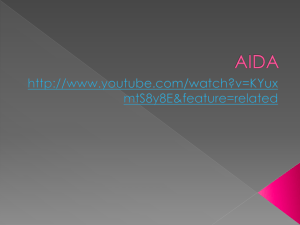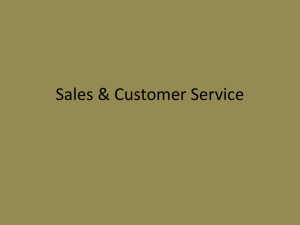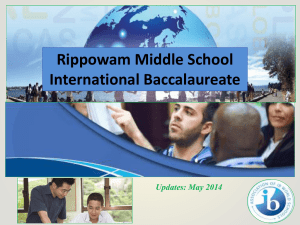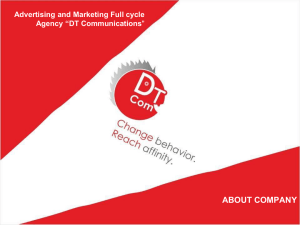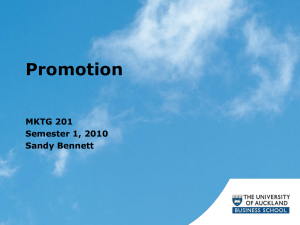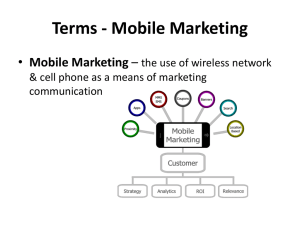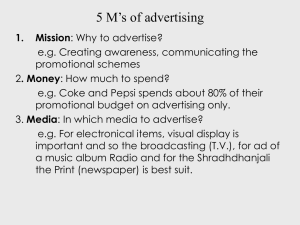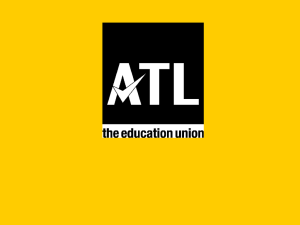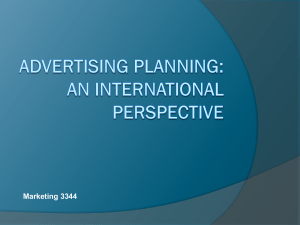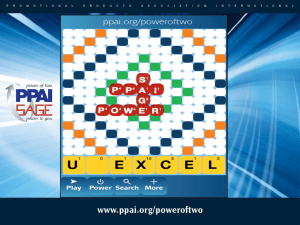4.5 - Promotion
advertisement
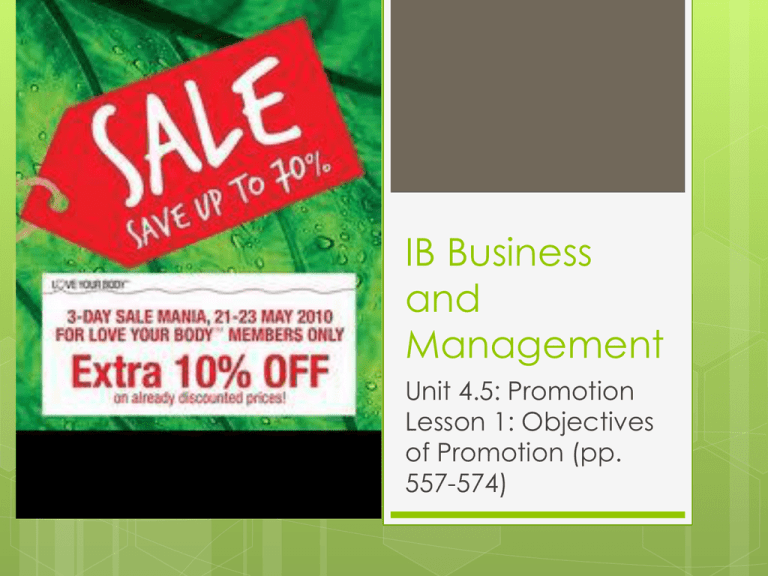
IB Business and Management Unit 4.5: Promotion Lesson 1: Objectives of Promotion (pp. 557-574) Think about it “ Advertising is the art of convincing people to spend money they don’t have for something they don’t need.” - Will Rogers (1879-1935) comedian What did Rogers mean by this quote? Are we constantly being deceived? Focus Questions 1. What are the objectives of promotion? 2. List and explain the types of promotion. 3. What is above and below the line promotion? 4. What is included in the promotional mix Promotion methods of communicating messages to the market when selling a firm’s product. promotion includes: sales promotion branding raising publicity (awareness) advertising campaigns Promotion is important during which stage of a product’s life cycle? LAUNCH Marketers must forecast probable impact on sales and then make the promotional budget. This is not easy. Promotion Objectives of promotion : inform: to alert the market about a firm’s product. persuade: to encourage customers to make a purchase. Product differentiation Comparison advertising remind: used to retain customer awareness and interest of an established product. These objectives will be in line with marketing department’s objectives, which are based on corporate objectives. Most types of promotions are….? PERSUASIVE Types of Promotion Fours types of promotion : 1. Above-the-line (ATL): use of mass media sources (TV, radio, magazine). 2. Below-the-line (BTL): use of non-mass media (free samples, buy1 get 1). 3. Pull promotion: used to stimulate (pull) demand. (ATL) 4. Push promotion: rely on intermediaries such as wholesalers and retailers to ‘push’ the products to customers. (BTL) Above-the-line Promotion ATL - any form of paid-for promotional technique through independent media. Such as: TV Radio Newspaper Internet Magazines Cinema Outdoor Advertising Above-the-line Promotion Advantages: ATL can reach a large audience of customers Customers more aware of ATL b/c they are more interesting/appealing Disadvantages: Promotion through mass media may not appeal to the right market segments Many advertisements are ignored (ie. People change channel during commercials, annoying pop-up ads on internet) Cannot determine effectiveness of ads b/c communication is one-way ATL Promotion - TV First American tv ad – 1941 UK television advertising industry worth $10billion/yr Most spending on this form of promotion than all the others Advantages: Can reach a global audience Can meet specific needs ie. Aimed at children during children’s tv shows Disadvantages: Huge costs During the Super Bowl, 1 commercial can be $2.6million for 30 seconds ATL Promotion - Radio Advantages: Reaches a large audience Significantly cheaper than tv ad. Disadvantages: Can only communicate audio messages, no visuals. People remember better w/ audio + visual Audiences have lower attention to audio rather than visual (tv) ATL Promotion - Cinema Going to the movies is income elastic More visitors go to movies therefore cinema is a growing medium for ads. Advantages: Can directly target the audience based on the movie Size of movie screen exerts more impact Audience is more likely to watch bc they cannot leave or switch channel Disadvantages: Limited audience ATL Promotion - Newspaper Advantages: Can reach a wide audience Much cheaper than tv ad. Can keep the ad around for awhile and can read the important info. at a later time Can better target different markets than tv (ie. Teaching jobs in The Educational Supplement or different socioeconomic classes based on the type of paper they read) Many newspaper firms have websites – can target wider audience Disadvantages: High costs, esp for small businesses Very short shelf life (people won’t read yesterday’s paper) ATL Promotion - Magazines Advantages: High photo-quality color images to attract Target specific market segments thru specialist magazines (Vogue, PC Gamer) Can refer to info at a later date (like newspaper) Longer shelf life than newspapers Disadvantages: Static, one company places many diff ads in the magazine Magazines have too many ads, so some are skipped over – advertising clutter Long lead-time from when ad is submitted until published ATL Promotion – Outdoor Advertising Billboards, banners, posters Sporting events, shopping malls, roadside, on vehicles Used by car manufacturers, food producers, clothing firms, tourism/leisure Advantages: Advances in billboard technology so can have more ads on each billboard and images and sound High rate of exposure Disadvantages: Difficult to monitor effectiveness b/c it is hard to target markets Prone to damage (bad weather, vandalism, graffiti) Too much clutter – high levels of competition Below-the-line Promotion BTL promotion refers to all forms of non-media promotion activities. Business has direct control over the production of all its advertisements. Such as: Branding Word-ofmouth Sales Promotions Slogans Direct Marketing Sponsorship Logos Direct Mail Packaging Publicity Point-ofsales Promotion Below-the-line Promotion We said before, ATL is paid for advertising to external media agencies BTL pays no commission to these external media. Instead business has control over production of ads BTL is usually cheaper than ATL Below-the-line Promotion - Branding Successful brands are instantly recognizable Virgin, Microsoft, Sony, Nike use branding to promote their company/products These types of companies use extension strategies to launch new products under brand name Below-the-line Promotion - Slogans Memorable catchphrases Concise message that represents essence of a business or product Many slogans have become so well known they are synonymous with the brand Successful slogan can give business competitive advantage Slogan should be: Memorable Creates desire Creates positive image Outlines benefits of product Below-the-line Promotion - Logos A form of branding that uses a visual symbol Logos are used by NPO’s as well such as: Companies spend millions of dollars coming up with the right logo Below-the-line Promotion - Packaging Almost every manufacturer/retailer makes carrier bags with the company name/logo on the bag Customers who reuse these bags are helping the company promote “Bag-vertising” Below-the-line Promotion – Word-of-mouth Spreading info through oral communication Possibly the most effective form of promotion bc there are no direct costs from the company However, can also be damaging if bad words spread about a company Similar method, peer-to-peer (P2P) – relies on electronic transfer of messages usually thru internet Viral Marketing – using internet for promoting Below-the-line Promotion – Direct Marketing Sell a product directly to customer. Does not use intermediary (store). EX: telemarketing, email, mail Advantages: Business can have larger share of profits Can do marketing their own way Disadvantages: Cost of producing and distributing promotional material ie. Brochures, catalogues, menus Most people ignore this ‘junk’ mail Below-the-line Promotion – Direct Mail Example of direct marketing Local restaurants and fast-food companies use this method Drawbacks: People may ignore Wastes resources May not target right audience Below-the-line Promotion – Sales Promotions Temporary ways to boost sales Types: BOGO Discount coupons Free samples Customer loyalty schemes Win prizes Drawback: Can be costly Only short term strategies Below-the-line Promotion – Point-of-sales Promotion at the place/location where the customer buys the product EX: supermarkets – while customers wait in line – impulse buys, displays, posters Below-the-line Promotion – Publicity Promoting a business through media coverage without directly paying for it EX: celebrities photographed wearing designer shoes/clothes – free promotion Ferrari gave away car to celebrity This type of publicity can be more beneficial than tv ads. Below-the-line Promotion – Sponsorship Business provides financial funds to support an event/organization in return for publicity EX: Arsenal Football Club received $178million from Emirates Airline in return for Arsenal naming their field “The Emirates Stadium” Promotional Mix “Set of tools that a business can use to communicate effectively the benefits of its products or services to its customers.” In other words, a range of above and below the line methods used to market a product. Promotional Mix When deciding on a promotional mix use AIDA : Attention: should raise awareness of the product Interest: should keep customers interested Desire: should generate a desire or feeling of ‘need’ for the product Action: should encourage customers to take action Another approach is FAB: Features Advantages Benefits Explains what the product will do for the customer Promotional Mix When creating a promotional strategy marketers should consider a combination of factors: cost of promotional medium nature of the product product’s position in its life cycle legislation Using a single promotional technique is unlikely to be effective; instead use many: 4 Key Elements of Promotional Mix 1. Advertising: “ the science of arresting the human intelligence long enough to get money from it.” form of promotion that is paid-for Tv, radio, billboards, email, in-store displays advertising can be informative or persuasive, or both. advertisement should be original and creative most businesses use advertising agencies to make their ads 4 Key Elements of Promotional Mix 2. Personal selling: relies on sales representatives directly helping and persuading potential and existing customers to make a purchase. EX: sales presentations, face-to-face meetings with clients (health insurance), telemarketing, door-todoor sales Benefit: tailored to the individual needs of the customers. can help company build positive, long relationship w/ customer Disadvantage: these sales agents can be expensive to hire 4 Key Elements of Promotional Mix 3. Public relations (PR) : aimed at establishing and protecting the desired image of an organization. concerned with getting good press coverage. PR experts will get media to report events in a positive way EX: having a presence at exhibitions, launch party, press conferences, radio/tv interviews, donating to charities PR is a long-term strategy and relied on when business faces a crisis 4 Key Elements of Promotional Mix 4. Sales promotion : short-term incentives designed to stimulate sales of a product. EX: discount coupons, prize draws, samples Advantages: can help gain short term competitive head start get rid of excess or old stock encourages customer loyalty attract new customers Disadvantage: costly Promotion and Business Strategy Often takes several attempts for a promotional message to be noticed Therefore, promotion can be very expensive Some critics believe this is wasteful and the money could be spent elsewhere Levi Strauss had tv commercial that increased sales 800%/yr Promotion relies creativity of marketers Promotion and Business Strategy Guerrilla marketing – promotional strategy to raise maximum exposure by using minimum input and/or unconventional methods uses ‘shock’ technique Supporters believe it is more effective and cheaper Marketers Ex: must obey laws cigarettes, fast food, box 4.5e Unethical promotions do exist and laws have been passed to protect consumers
